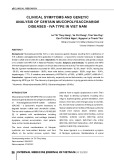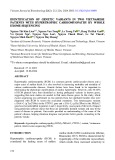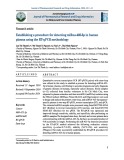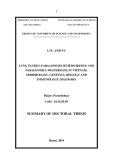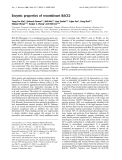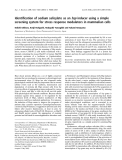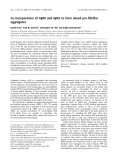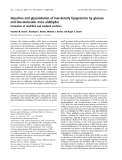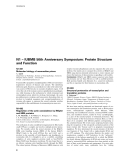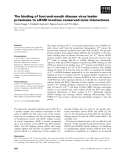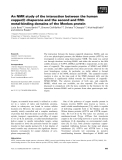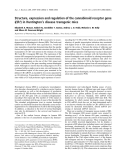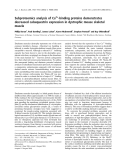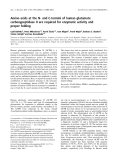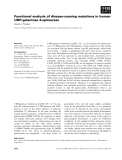
Genetic diseases
-
Clinical symptoms and genetic analysis of certain mucopolysaccharide diseases - IVA type in Viet Nam
Mucopolysaccharide IVA is a rare recessive genetic disease resulting from a deficiency of N 6 sulfatase acetylgalactosamine (galactose 6 sulfatase) - a lysosome’s enzyme necessary to degrade keratan sulfate and chondroitin sulfate. Objectives: To describe clinical characteristics and genetic analysis of 13 children with MPS IVA in National Pediatric Hospital.
 8p
8p  viengfa
viengfa
 28-10-2024
28-10-2024
 2
2
 2
2
 Download
Download
-
Hypertrophic cardiomyopathy (HCM) is a common genetic cardiovascular disease and a major cause of sudden death. It is also involved in increasing morbidity and mortality of various cardiovascular diseases. Genetic factors have been found to be important in determining the phenotypic manifestation of cardiac hypertrophy. However, only 50–60% of HCM patients have been identified as having pathogenic variants in known genes, suggesting that more studies are needed to find more disease genes.
 15p
15p  xuanphongdacy06
xuanphongdacy06
 18-09-2024
18-09-2024
 8
8
 1
1
 Download
Download
-
Quantitative reverse transcription PCR (RT-qPCR) paired with stem-loop was utilized in this study to establish a process for detecting miRNA-425-5p in human plasma, contributing to accurate prognosis and early diagnosis of genetic diseases in humans, especially cancer diseases. Blood samples (n=12) collected from healthy volunteers in Ho Chi Minh City, were subjected to plasma extraction and then microRNA (miRNAs) isolation using the TRIzol method.
 11p
11p  vihyuga
vihyuga
 04-03-2025
04-03-2025
 6
6
 1
1
 Download
Download
-
Single-nucleotide polymorphisms (SNP) are common genetic changes in the human genome. In recent time, many scientists have shown their interests in studies on SNPs’ roles in the pathological risk especially in cancer and metabolic diseases.
 27p
27p  tamynhan0
tamynhan0
 15-06-2020
15-06-2020
 23
23
 1
1
 Download
Download
-
The objective of the thesis is to know about two species of SLP P.heterotremus and P. westermani, providing a scientific basis for the diagnosis and prevention of SLP disease, contributing to protecting public health.
 27p
27p  xacxuoc4321
xacxuoc4321
 11-07-2019
11-07-2019
 58
58
 4
4
 Download
Download
-
Agrobacterium tumefaciens is a Gram-negative, phytopathogenic bacterium and is characterized by an unique mode of action on dicotyledonous plants: it is able to genetically modify the host, and because of this feature, it is used as a tool for transgenic plants. Many experiments have demonstrated that lipopolysaccharides (LPSs) play an important role for the disease development, as they are involved in the adhesion process of the bacterium on the plant cell wall.
 4p
4p  system191
system191
 01-06-2013
01-06-2013
 35
35
 4
4
 Download
Download
-
BACE2 (Memapsin 1) is a membrane-bound aspartic pro-tease that is highlyhomologouswithBACE1 (Memapsin 2). While BACE1 processes the amyloid precursor protein (APP) at a key step in generating theb-amyloid peptide and presumably causes Alzheimer’s disease (AD), BACE2 has not been demonstrated to be directly involved in APP pro-cessing, and its physiological functions remain to be deter-mined.In vivo, BACE2 is expressed as a precursor protein containing pre-, pro-, protease, transmembrane, and cyto-solic domains/peptides....
 10p
10p  tumor12
tumor12
 22-04-2013
22-04-2013
 26
26
 2
2
 Download
Download
-
The Nipah and Hendra viruses are highly pathogenic paramyxoviruses that recently emerged from flying foxes to cause serious disease outbreaks in humans and livestock in Australia, Malaysia, Singapore and Bangladesh. Their unique genetic constitution, high virulence and wide host range set them apart from other paramyxoviruses. These characteristics have led to their classification into the new genus Henpaviruswithin the family Para-myxoviridae and to their designation as Biosafety Level 4 pathogens. ...
 10p
10p  tumor12
tumor12
 20-04-2013
20-04-2013
 34
34
 2
2
 Download
Download
-
Asheat shockproteins (Hsps) are involved inprotecting cells and also in the pathophysiology of diseases such as inflam-mation, cancer and neurodegenerative disorders, modula-tors ofHsp expression inmammalian cells would seemto be useful for the treatment of various diseases. In this study, we isolated mammalian cell lines for screening of Hsp modu-lators; mouse C3H10T1/2 cells stably transfected with a plasmid containing the mouse Hsp105 or human Hsp70B promoter upstream of a luciferase or b-galactosidase reporter gene, respectively....
 8p
8p  tumor12
tumor12
 20-04-2013
20-04-2013
 36
36
 5
5
 Download
Download
-
Senile plaques, the invariable hallmark and likely proximal cause of Alzheimer’s disease (AD), are structured deposi-tions of the 40- and 42-residue forms of the Abpeptide. Conversely, diffuse plaques, which are not associated with neurodegeneration, consist mainly of unstructured Ab42. We have investigated the interaction between Ab40 and Ab42 through an assay, which involves labeling both vari-ants with an environment-sensitive fluorophore.
 10p
10p  tumor12
tumor12
 20-04-2013
20-04-2013
 31
31
 3
3
 Download
Download
-
Patients with diabetes mellitus suffer from an increased incidence of complications including cardiovascular disease and cataracts; the mechanisms responsible for this are not fully understood. One characteristic of such complications is an accumulation of advanced glycation end-products formed by the adduction of glucose or species derived from glucose, such as low-molecular mass aldehydes, to proteins.
 11p
11p  fptmusic
fptmusic
 16-04-2013
16-04-2013
 35
35
 3
3
 Download
Download
-
Transmissible spongiform encephalopathies (TSE) are fatal neuro-degenerative diseases of humans and animals. The underlying infectious agent, the prion, accumulates not only in the central ner-vous system (CNS) but also in secondary lymphoid organs. I will revisit the role of the immune system in peripheral prion pathogen-esis, while focusing on the mechanisms by which extraneural and extralymphatic prion infectivity develops.
 64p
64p  fptmusic
fptmusic
 11-04-2013
11-04-2013
 37
37
 4
4
 Download
Download
-
The leader proteinase (L pro ) of foot-and-mouth disease virus (FMDV) ini-tially cleaves itself from the polyprotein. Subsequently, L pro cleaves the host proteins eukaryotic initiation factor (eIF) 4GI and 4GII. This prevents protein synthesis from capped cellular mRNAs; the viral RNA is still trans-lated, initiating from an internal ribosome entry site. L pro cleaves eIF4GI between residues G674 and R675. We showed previously, however, that L pro binds to residues 640–669 of eIF4GI.
 10p
10p  awards
awards
 06-04-2013
06-04-2013
 39
39
 4
4
 Download
Download
-
The interaction between the human copper(I) chaperone, HAH1, and one of its two physiological partners, the Menkes disease protein (ATP7A), was investigated in solution using heteronuclear NMR. The study was carried out through titrations involving HAH1 and either the second or the fifth soluble domains of ATP7A (MNK2 and MNK5, respectively), in the pres-ence of copper(I). The copper-transfer properties of MNK2 and MNK5 are similar, and differ significantly from those previously observed for the yeast homologous system. ...
 7p
7p  awards
awards
 05-04-2013
05-04-2013
 47
47
 2
2
 Download
Download
-
Loss of cannabinoid receptors (CB1) occurs prior to neuro-degeneration in Huntington’s disease (HD). The levels and distribution of CB1 RNA were equivalent in 3-week-old mice regardless of genotype demonstrating that the specific factors and appropriate chromatin structure that lead to the transcription ofCB1were present in the striatum of young R6/2 and R6/1 transgenic HD mice.
 12p
12p  awards
awards
 05-04-2013
05-04-2013
 59
59
 5
5
 Download
Download
-
Duchenne muscular dystrophy represents one of the most common hereditary diseases. Abnormal ion handling is believed to render dystrophin-deficient muscle fibres more susceptible to necrosis. Although a reduced Ca 2+ buffering capacity has been shown to exist in the dystrophic sarco-plasmic reticulum, surprisingly no changes in the abundance of the main luminal Ca 2+ reservoir protein calsequestrin have been observed inmicrosomal preparations.
 0p
0p  awards
awards
 05-04-2013
05-04-2013
 45
45
 3
3
 Download
Download
-
Human glutamate carboxypeptidase II (GCPII) is a co-catalytic metallopeptidase and its putative catalytic domain is homologous to the aminopeptidases fromVibrio proteolyticus and Streptomyces griseus.In humans, the enzyme is expressed predominantly in the nervous system and theprostate.Theprostate form, termedprostate-specific membraneantigen, is overexpressed inprostate cancer and is used as a diagnostic marker of the disease.II
 9p
9p  dell39
dell39
 03-04-2013
03-04-2013
 42
42
 4
4
 Download
Download
-
We have investigated the conformational changes of New-castle disease virus (NDV) glycoproteins in response to receptor binding, using 1,1-bis(4-anilino)naphthalene-5,5-disulfonic acid (bis-ANS) as a hydrophobicity-sensitive probe. Temperature- and pH-dependent conformational changes were detected in the presence of free bovine gan-gliosides. The fluorescence of bis-ANS was maximal at pH 5.
 8p
8p  dell39
dell39
 03-04-2013
03-04-2013
 43
43
 4
4
 Download
Download
-
The macrophage is critical to the innate immune response and contributes to human diseases, including inflammatory arthritis and plaque formation in atherosclerosis. Vascular endothelial growth factor (VEGF) is an angio-genic cytokine that is produced by macrophages.
 14p
14p  dell39
dell39
 27-03-2013
27-03-2013
 41
41
 4
4
 Download
Download
-
UDP-galactose 4-epimerase (GALE, EC 5.1.3.2) catalyses the interconver-sion of UDP-glucose and UDP-galactose. Point mutations in this enzyme are associated with the genetic disease, type III galactosemia, which exists in two forms – a milder, or peripheral, form and a more severe, or general-ized, form.
 8p
8p  dell39
dell39
 27-03-2013
27-03-2013
 52
52
 5
5
 Download
Download
CHỦ ĐỀ BẠN MUỐN TÌM








